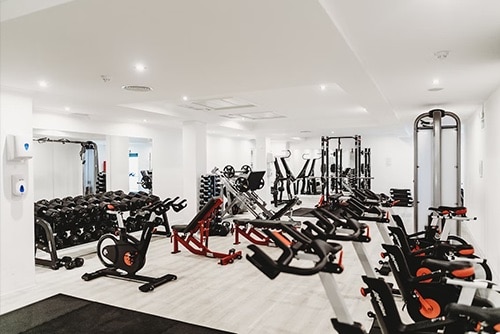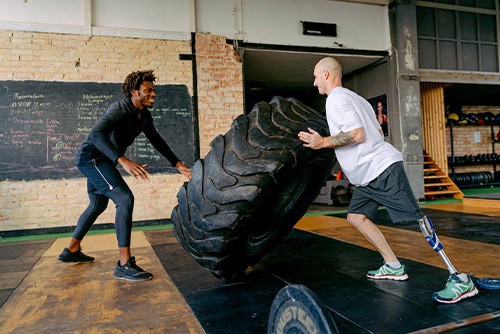29 Proven Grand Opening Ideas For Small Businesses
Your business’s grand opening is a very exciting — and important, and nerve-...

If you’re interested in learning how to open a gym, you’ve come to the right place.
In this article, we discuss some of the key steps for opening a physical fitness center and introduce you to a tool that can make opening, organizing, and operating any business much easier.

The first step in learning how to open a gym is to research the physical fitness industry in your area. The internet is a valuable source of information, but you can also talk to a person at your local Better Business Bureau or Chamber of Commerce.
You might also consider talking to friends, family, and acquaintances who are avid gym-goers. Getting a customer-centric point of view can go a long way toward helping you make the right decisions.
As you go about your research, ask a lot of questions — and not just about the physical fitness side of things — such as:
The more questions you ask now, the easier it will be to make decisions later on in the process.
One of the best ways to decide if you even want to open a gym is to work in one for a while.
Doing so will give you valuable insight into what it takes to run this type of business on a daily basis, including fundamentals like:
The experience you gain will only improve your ability to make your own gym a success.
Another important variable to think about when considering how to open a gym is what type you want to operate.
Your gym can be a general-purpose fitness facility, or you can set it up to be a:
Each has a different focus, pulls in a different clientele, and requires different equipment.
As you investigate the different types of gyms, keep in mind that the narrower your focus — i.e., powerlifting and Olympic lifting — the narrower your pool of potential customers may be.
Coming up with a cool name for your gym can be one of the most difficult steps to complete.
That’s why we recommend brainstorming possibilities early on in the process. Doing so first thing gives you plenty of time to settle on a favorite before you have to start filling out paperwork.
After you’ve completed the next few steps in the process, it can be very difficult — not to mention costly — to change the name in all the necessary places so that your business operates lawfully.
Think of your gym’s business plan as a roadmap to success.
Not only can it help you in the early stages of getting your new business up and running, but it can also help you months and years down the road as your operation continues to grow and thrive.
Learning how to open a gym is like planning a road trip. You choose the route that will get you to your destination the quickest or the route that allows you to see certain sights along the way. You might even make note of alternate routes should you run into problems.
So, just like the map you use on your road trip, the business plan can help you plot out the route you want to take to reach your goals and provide alternate directions if things go wrong.
At the most basic, a business plan includes four sections:
More comprehensive business plans may also include:
Another important thing to remember about your gym’s business plan is that it does much more than help you plan. It can also help you get the money you need to make your dream of opening a gym a reality.
Opening a gym can be an expensive undertaking. Renting or buying space, outfitting that space, and buying equipment can get very expensive very quickly.
Chances are, you’re going to need some form of financing along the way.
You may decide to take out a small business loan from your local bank. You may take on a partner or two. Or, you may line up investors who are willing to supply you with startup capital in exchange for a certain percentage of your profits.
However you choose to do it, your gym’s business plan may become an integral part of the process.
Loan managers, partners, and investors will likely want to see that you’ve got a plan in place to make your gym a success and that you’re not just flying by the seat of your pants.
As we mentioned, opening a gym can be an expensive endeavor. Make sure you have enough capital in your bank account to cover the costs of purchasing the equipment you need.
Even if you use a credit card to buy supplies, do your best to pay it off as quickly as possible so high interest rates don’t become a problem.

Some gyms include a pool, sauna, or hot tub as part of the amenities they offer their members.
You’ll need to decide if you want one or more of these options in your operation before you get too deep into the planning and preparation phases of opening a gym.
While these features can be a perk that draws customers in and keeps them coming back, they also come with a long list of drawbacks.
For example, as a general rule, there are no federal, state, or local “health codes” for gyms. But, if you choose to include a pool, sauna, or hot tub in your operation, you may have to abide by certain laws, regulations, insurance, and inspection guidelines.
Pools, saunas, and hot tubs also require extensive regular cleaning with special chemicals and the knowledge to get it all done correctly.
For these and other reasons, you may decide to forego installing a pool, sauna, or hot tub — at least at first — in order to save money as you learn how to open a gym and make it successful.
If you do decide to add one of these options to your operation, be sure to talk to an attorney and investigate the guidelines that apply.
You may also be considering installing a cafe in your gym to provide customers with healthy snacks, meals, and beverages pre- and post-workout.
That can be a boon for your operation, but, like the amenities mentioned above, food service of any kind comes with a long list of regulations that may make it cost-prohibitive for first-time gym owners.
Every town, city, or local government has requirements and health codes that dictate what you can and cannot do when serving food and drink to patrons.
In essence, the small cafe you want to install in the corner of your gym may be considered a restaurant by your local government and, thereby, subject to all applicable laws.
Those laws may dictate that you have to install food-grade equipment and will be subject to periodic inspections. Both of those things can be expensive and time-consuming hurdles that you don’t necessarily want to deal with when you’re first learning how to open a gym
Take the time to research local health and safety guidelines for food-service operations and weigh the pros and cons of installing such a feature in your gym.

Opening a gym and making it successful can be largely dependent on where the business is located.
Basic criteria for a fitness facility might include:
Depending on where your gym will operate, it might be advantageous to go through a commercial real estate broker so you can learn as much and find the best space possible.
Once you’ve entered the preparation phase of opening a gym, it’s time to register your business with the appropriate local, state, and federal agencies.
(It’s at this stage of the game that you’ll want to have a name in mind to write on the forms.)
Start by visiting the website for your secretary of state. Some states allow you to fill out forms and pay online, while others require you to download, print, and mail the completed forms along with your payment. Your local secretary of state’s office will have the details you’ll need to get set up.
Similarly, depending on where your business is located, you may need to visit your local government offices to register there as well.
You’ll also need to register with the federal government in order to get a Taxpayer Identification Number (TIN) or Employer Identification Number (EIN) from the IRS. You may also need a state EIN depending on your location. Again, discuss your plans with a tax professional.
With your local, state, and federal registration in hand, now you’ll want to consider how you’ll manage your new gym’s finances.
Make sure you speak with an accountant and tax professional for advice, but some business owners prefer to not mix your personal and professional finances.
With a dedicated business bank account that is kept separate from personal finances, you won’t have to go through the arduous and time-consuming process of separating personal expenses and income from business expenses and income at the end of the year.
Learning how to open a gym is not without risk. Someone could injure themselves while on premises, and your business could be liable.
Such an event could put your gym on the hook for paying medical bills and even legal fees.
That’s what business insurance is for. Speak with an insurance consultant, and find a plan that can help you protect your gym.
Managing employees can be one of the trickier aspects of operating any business, including a gym. Thankfully, modern workforce-management technology has made things dramatically simpler.
Now, one suite of tools can sometimes do it all, including:
Integrated technology like this will help your team get as much done as possible in a day, provide exceptional customer service, and keep your business moving in the right direction.

If you decide to investigate financing, you’ll need some type of financial description within your business plan so prospective investors and loan managers can get a sense of your operation.
In addition to that financial description, you’ll also likely need to put together an operating budget. Doing so can help you control costs once your gym opens its doors. A budget can also prevent you from overspending and eating into all the profits you bring in.
Start by budgeting for the big-ticket, necessary items such as utilities, cleaning supplies, tools, uniforms, computers, and software.
Once the business really gets going, you may find other necessary expenses — stamps, business cards, name tags, printer paper, etc. — that you’ll want to add to the budget as well.
Setting your pricing is an important step in the process of learning how to open a gym.
You’ll need to consider things like:
As you consider your pricing options, be sure to include certain percentages for expenses you incur such as taxes, overhead, supplies, and, of course, profit.
If you’re unsure how to set your pricing, talk to other gym owners, do some research online, or talk to an attorney or accounting professional in your area.

A big part of your business — if not the biggest — is the equipment you offer in your facilities. If you plan on operating a specialized gym, only purchase the equipment that appeals to that specialty right now.
You can always add new hardware later, but you don’t want to blow your budget on items that won’t get any use.
Hiring employees for your burgeoning gym business can be a daunting task at first. But, if you take it step by step, you’ll find that it gets easier the more you do it.
Start by writing a job description and posting it everywhere you can. When you find someone who is interested in working with you, interview them, check their references, hire them, and then train them to operate according to your business model.
If you want patrons to train at your gym, you’re going to have to advertise. But that doesn’t mean you have to spend big bucks for TV, print, and radio campaigns.
Those things may help, but you may choose to employ one or more free and inexpensive methods first, including:
Get creative with your advertising and try to reach as many people as possible.
If they really wanted to, people could exercise at home or just go for a walk, run, or ride outside. In many cases, though, your gym customers will frequent your establishment because of the welcoming atmosphere they experience when they walk through your doors.
Right from the get-go, put customer service first and encourage your team to do the same. Keep in mind that you’re not necessarily producing anything — you’re just providing access to a resource your customers need. Other places do that as well.
What can really set you apart from the competition and bring people through the door is the friendly service they receive at your establishment.
While planning and preparation are an important part of putting your gym on the path to success, it’s your daily operations that make the most difference.
Once your gym gets going, you’ll likely find things that you didn’t consider or think about.
That’s OK! Even the most comprehensive, well-researched plan will miss some details. That’s just the nature of the beast.
If you encounter a hurdle that you didn’t see coming, don’t let it trip you up. Make adjustments and keep moving forward toward your goals.
You may need to make changes to your business plan and your budget, but that’s just par for the course when it comes to running a business.
Monitor the day-to-day activity in your gym by examining such metrics as:
Keeping track of data like this is an essential part of running a gym and gives you the ability to see “inside” your business and identify where adjustments need to be made to keep everything on the road to success.
While that may seem like a tall order, you don’t have to do it all by hand if you harness the power of technology to keep all your data, your team, and your business as organized as possible.

Organization is essential for the success of your gym.
Once open, your focus will turn to maintaining hours of operation, keeping track of personal training appointments, coordinating your team, and much more. That in itself can be a full-time job.
The right software can reduce the time it takes to coordinate all the infrastructure that keeps your gym running smoothly. Sling is a complete workforce management solution built to simplify all the essential activities that go into running a business.
The Sling app makes it easier than ever to optimize your entire team so you can spend more time building your business rather than just running it.
For more free resources to help you manage your business better, organize and schedule your team, and track and calculate labor costs, visit GetSling.com today.
See Here For Last Updated Dates: Link
This content is for informational purposes and is not intended as legal, tax, HR, or any other professional advice. Please contact an attorney or other professional for specific advice.
Schedule faster, communicate better, get things done.